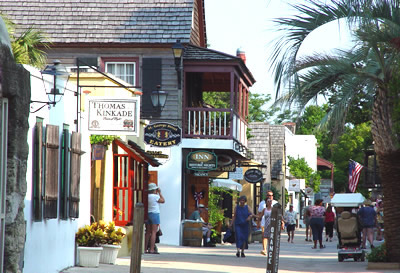St. Augustine, Florida
![]()
Kayaking St Augustine (February 2002)
A clear, crisp late winter day finds a friend and I setting off for a paddle in the St. Augustine area.
Our timing is good. Tides that day have the currents flowing toward the town as we head toward it, and the current is heading out to the beach on our return trip.
We hug the beach heading west from Anastasia in the Intracoastal Waterway, and have lots of close-up encounters with skittish yet curious wading birds. We cross the Waterway to skirt along the sea walls protecting the wealthy homes on the west and north sides of the Waterway, being careful not to be catastrophically crushed by speeding motorboats as we cross.
The paddle is easy, relaxing and quiet. We tie up the boats at the St. Augustine marina dock next to a schooner. We set off for a stroll into the exceptionally well-designed, walkable urban streets of the historic town, in quest of seafood and good beer.
After completing an excellent seafood dish and sampling a number of their delicious micro beers at the Ale House balcony overlooking the harbor, we head out under cover of darkness.

More about St. Augustine
The nation's oldest city, settled by the Spanish 55 years before the Pilgrims first arrived on Plymouth Rock. Don Juan Ponce de Leon reached Florida in 1513 (he was later to be the first governor of Puerto Rico). He claimed Florida for the Spanish Crown and named it Florida because he first sighted it on Easter Sunday, which in Spanish is "Pascua Florida."
In 1565, Don Pedro Menendez de Aviles reached Florida and established the City of St. Augustine, which was given that name to honor Saint Augustine. Catholics celebrate Augustine on August 28th, which is the day Menendez de Aviles first sighted the Florida shoreline. The town was established to begin colonization in the new Spanish territory of Florida, and to help protect ships from pirates and British and French sabotage. The Castillo de San Marcos is a massive fortress and National Monument completed in 1695.
St. Augustine, today, is the oldest continuously occupied European settlement in America, making it the oldest city in the United States.
The emphasis on "first European settlement" acknowledges that the Timucuan Indians were here first and observed Menendez and his party of about 1,500 soldiers and colonists. Located 50 miles south of the Georgia border on Florida’s east coast, the town was first established to begin colonization in the new Spanish Territory recently christened "Florida." The city was first intended to help protect ships from pirates, and from British and French sabotage.
Over the course of centuries, the city has been under the governments of Spain, 1565 to 1763 and 1784-1821; Britain, 1763-1784, and United States, 1821-present. Florida became a state in 1845. It was part of the Confederacy from 1861-1862 when it returned to Union control.
St. Augustine in the late 1880s had its birth as a resort community with the arrival of Standard Oil co-founder Henry M. Flagler. He built two hotels and took over another to serve as the base of his Flagler System hotels. He founded the Florida East Coast Railway as a means of transporting guests to and from the north to his hotels in St. Augustine, Palm Beach, and Miami.
Three of his former St. Augustine hotels are in use today as Flagler College (Hotel Ponce de Leon), Ligntner Building/City Hall (Alcazar) and Casa Monica, redone as a county courthouse in the 1960's. In February 1997 Richard C. Kessler of The Kessler Enterprise, Inc. of Orlando purchased the Courthouse. On December 10, 1999 Richard C. Kessler opens the doors to the restored Casa Monica Hotel. Flagler also developed a neighborhood of 19th and early 20th century homes, two blocks west of the Plaza called the Model Land Company tract.
The heart of the city is its downtown Plaza de la Consitucion with most of the historic buildings located within a block or two of the Plaza, to the north and to the south. The Castillo de San Marcos, built of coquina by the Spanish in 1672, anchors the city's north end of the bayfront. The Bridge of Lions, built in 1927, links the downtown with Davis Shores, a residential community dating back to the 1920s and St. Augustine Beach.
Today's city has 12,000 residents. It is the county seat of St. Johns County which has 130,000-plus residents.

As America’s oldest city, St. Augustine is fortunate to be a city based on timeless, walkable urban, human-scaled, medieval charm. Indeed, the public square in the middle of town, built nearly 500 years ago, still retains a delightful presence. Walking the narrow, old-world streets is romantically pleasant.
Also in the heart of the town is a wonderful pedestrian mall that is a joy to walk. Lined with shops, the mall is an important part of the St. Augustine experience.
Many buildings are graced with brightly colored bougainvillea which are often found flowing over walls and out of windows, adding to the walkable ambience.
As noted above, St. Augustine is home to Flagler College, a school which boasts spectacular, proud architecture and sitting on a lushly gardened campus.
The City is graced with three hotels built using Spanish architecture by Florida's premier historical developer, Henry Flagler. Today, one is a County Courthouse, one is City Hall, and one is the Lightner Museum.
I find it a city rich in old world historical buildings, sheltered gardens, exotic eateries, romantic lodging, quiet streets, and magnificent trees. I especially enjoy the narrow pedestrian mall in the heart of downtown. It is popular and filled with shops and restaurants.
Back to Dom's Voyages and Adventures page.
Back to Gainesville page.